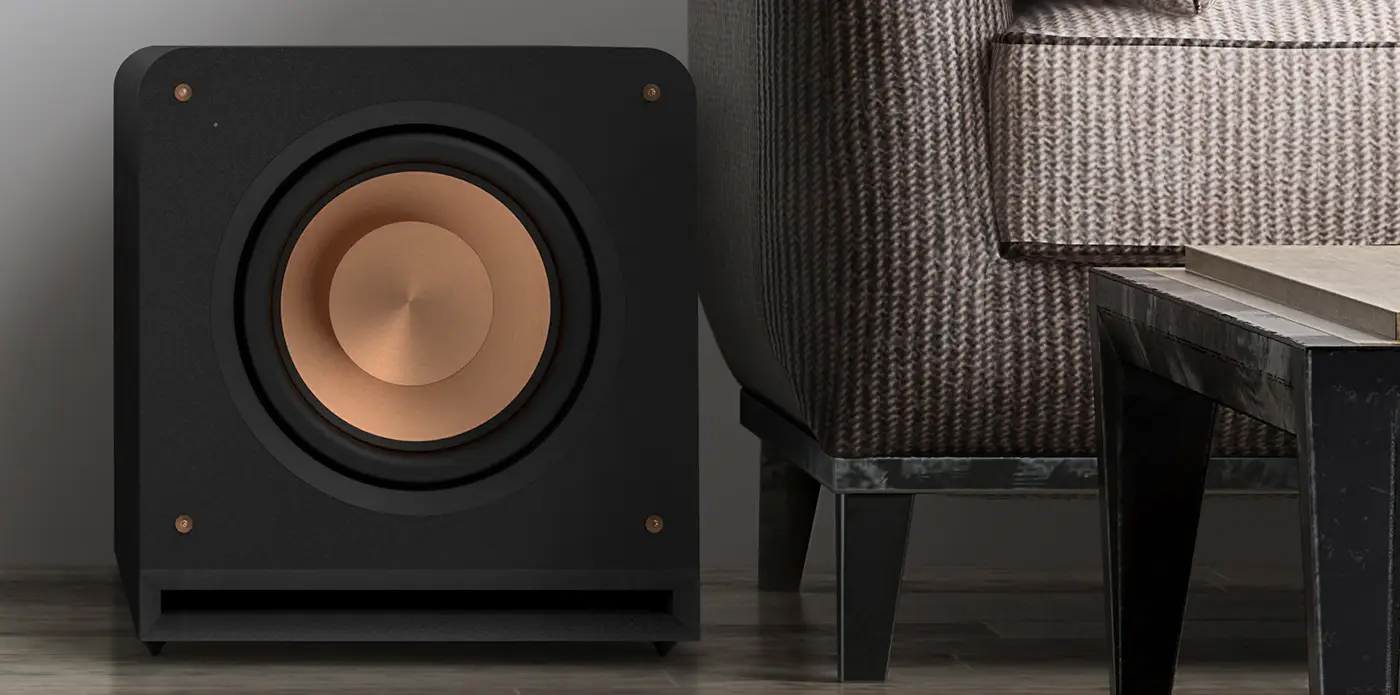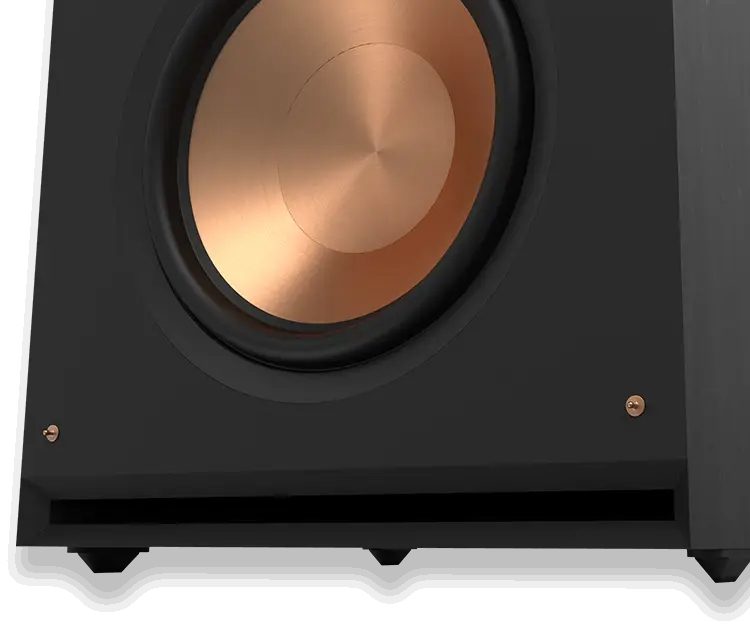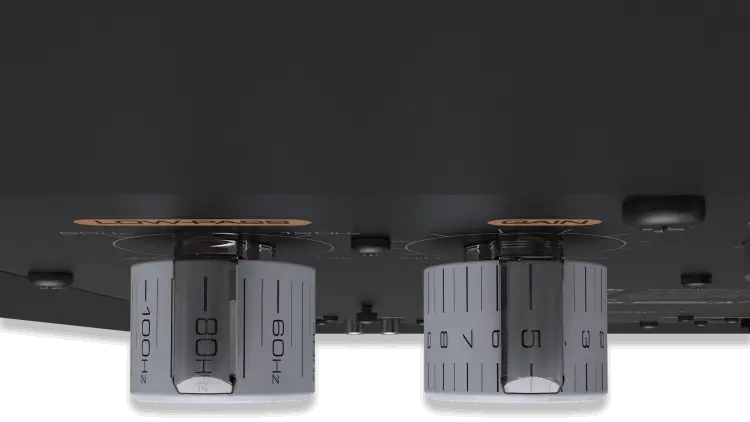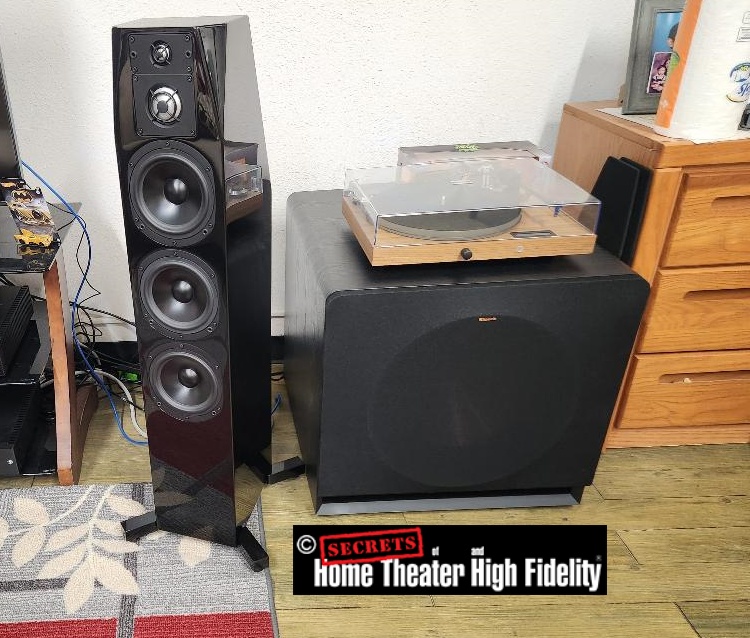The Klipsch RP-1600SW is a large subwoofer with a big voice. It did not disappoint in the reproduction of music and movie soundtracks. Although not inexpensive, the RP-1600SW is a bargain for the performance it provides.
Klipsch RP-1600SW Subwoofer Highlights
- 16” Ultra Long Throw Cerametallic Woofer.
- 800-watt RMS/1600-watt Peak Class D amplifier.
- Variable Low Pass Crossover.
- Variable Phase Control.
- Aerofoil slot port design.
- Wireless capable with additional Klipsch WA-2 kit.
The Klipsch RP-1600SW is the company’s largest and latest subwoofer for home theater and 2-channel audio systems. Famous for advancing and improving the horn loudspeaker type, Klipsch has created a new line of subwoofers to complement its broad loudspeaker collection. I was excited to hear this new subwoofer as I have owned and enjoyed Klipsch speakers in my home for decades. Did I mention that I also like bass?
Although I knew this would be a large speaker, I was not prepared for its size when it arrived. Neither was my UPS guy. He peeked in the door to my store and said, “You have a BIG box!” There was a worried look on his face. When I went out to look at the Klipsch RP-1600SW, I understood. I was not sure how we could fit it through the door, but we managed. Now, I know the loudspeaker optimist might say that size doesn’t matter so much, but I like big things, especially big speakers. I also seem to remember Paul W. Klipsch famously stating that, “you can’t miniaturize the waveform.” Is this, the biggest of Klipsch’s new subwoofers really that much better? I was curious to find out.
Frequency Response:
14.5Hz – 175Hz +/-3dB
Maximum Acoustic Output:
125.5dB
Amplifier Type:
Class D with Analog Preamp Stage
Amplifier Power:
800W RMS/1600W Peak
Woofer:
16” Ultra Long Throw Cerametallic
Enclosure Material:
MDF
Enclosure Type:
Bass Reflex via Front Firing Aerofoil Slot Port
Inputs:
Dual RCA/LFE Line In, WA-2 Wireless Port
Height:
23.39”
Width:
23.50”
Depth:
27.35”
Weight:
110.9lbs
Finish:
Ebony Vinyl
MSRP:
$1799.00
Company:
SECRETS Tags:
klipsch, subwoofer, bass, reference, woofer
Secrets Sponsor
The Klipsch RP-1600SW represents the latest research and design in integrated all-in-one subwoofers from this respected company. Like previous home subwoofer designs the RP-1600SW features a dedicated woofer, crossover, and amplifier all in one box. The RP-1600SW is easy to add to almost any receiver, pre-amp processor, or integrated amp. Only pre-outs or sub-outs are necessary to connect this subwoofer. In addition, Klipsch offers a wireless adaptor, the WA-2, that will allow for easy placement in your room.
Although Klipsch is known for its horn loudspeaker technology, the RP-1600SW is a bass-reflex design. Klipsch does offer horn-loaded subwoofers in their pro line. These are very large and are normally used in Cinemas or for concert arenas. The bass reflex design helps keep the size and cost reasonable for home installations.
Although Klipsch has offered bass-reflex-type subs in the past, the RP-1600SW has a new style port that fires toward the front of the speaker. I think this is a good choice to have the port front firing as it allows for the most flexible placement of the woofer in the room. The port design itself is new for Klipsch as it is as wide as the front of the speaker and flared. Klipsch calls this design Aerofoil. The Aerofoil port is said to reduce air turbulence coming from the woofer.
The RP-1600Sw also has a powerful (800-watt) internal amplifier. One feature that sets this design apart from other subs is that Klipsch has engineered an analog pre-amp stage to drive the Class D output stage. Klipsch maintains that doing this ensures a truer performance experience for the listener.
In order to integrate with the sound system, Klipsch has an exceptional crossover with adjustable points from 40Hz to 140Hz. The crossover knob is next to the gain knob on the back top of the RP-1600SW. I really like this design because I am a mature audiophile whose eyes are not what they used to be. The knobs are also large and rotate very smoothly. With the RP-1600SW I was able to easily look behind the subwoofer and make the adjustments I needed. Klipsch has also placed a toggle switch on the back to adjust the phase from 0 to 180 degrees. I know some audiophiles will prefer a variable control for phase. However, I think you will be able to blend the RP-1600SW into your system and room very well with the controls provided by Klipsch. I got excellent results.
Now for the driver itself, it is a redesigned 16” driver that has benefited from Klipsch’s extensive experience designing and building speakers. What will be familiar to audiophiles is the Cerametallic, copper speaker cone that is used throughout much of the Klipsch line of speakers. If my memory serves me right, I think that Klipsch has relied on the Cerametallic cone for at least twenty years to bring great sound to the homes of many listeners. That being said, Klipsch has added refinements to the basket, spider, and magnet assembly to create this new woofer. It is a very large driver. For someone upgrading from a 12” driver to a 16” driver, it’s like going from a V8 engine to a V12 engine. More horsepower, more air for the music and movies you will listen to and experience.
For added stability and acoustic decoupling from the floor, the Klipsch RP-1600SW features new rubber feet. The new feet are unlike anything I have seen before, but they do add to the aesthetic look of the woofer. Externally the woofer housing is wrapped in an ebony vinyl finish that is very nice looking, understated, and featuring rounded edges on the top sides. The substantial grille has a woven cloth grille with a copper Klipsch logo on top. Removing the grille, you will see that the pins for holding the grille in place are also copper colored. It’s a nice touch and adds to the beauty of the RP-1600SW.
As I mentioned earlier in the review, the size and weight of the Klipsch RP-1600SW are imposing. Thankfully I have my audiophile friend Matt who is always willing to lend a hand. If you should want to have this subwoofer, I very much recommend that you have help unboxing this beast. The subwoofer is well packed and protected, so when we took the final plastic liner off, I could see that the speaker was in perfect condition.
To check that the internal sub amp and speaker were functioning I decided to place the RP-1600SW just slightly behind the outside of the right channel tower speaker. This was the shortest cable run to the pre-amp without having to move the front channel speakers to accommodate the large box between them. I thought the sound was effective with the sub in that position, so it stayed there for the duration of the review.
I need to point out here that the review was done as a 2-channel system. I know that many of these subs will go into surround systems. If you have a surround system, the set-up will be different in that surround receivers and processors will have automated set-up programs for their systems. Use the program in your processor/receiver for the best integration in the surround system. For surround processors or receivers, the output labeled sub-out should be used and the single RCA will connect to the input labeled LFE on the back of the subwoofer.
The Klipsch manual recommends setting the subwoofer volume level on a surround processor or receiver to halfway or 0 dB position. Once this is done, the level or gain on the subwoofer itself can be set to match the sound level of the main speakers. One of the features I really like about this subwoofer is that Klipsch has put large knobs with settings on the back top of the RP-1600SW. It is very easy to see and set the crossover and level or volume on the sub. Most manufacturers recommend setting the crossover level on a subwoofer at 80Hz. The level of the gain will of course vary due to your room and speakers. After this initial setup, the receiver or processor will control the volume of the entire system.
To help fine-tune the RP-1600SW to the room and system, the subwoofer has a phase switch, and a switch to set the power to the sub amp to standby, on, or auto. I selected auto as the amp will switch on and off when it detects a signal from the processor or receiver. The phase switch will acoustically match the RP-1600SW’s output to the main speakers. Now, I know some purists will point out that the RP-1600SW should have a variable phase control. Some audio competitors’ subs do offer this feature, and while it could be useful, I do not consider this a deal breaker when considering this subwoofer. I was able to get very good blending with the RP-1600SW and the speakers I used it with.
For this review, I used the Rotel RC-1590 pre-amp and Rotel RB-1552MkII amplifier. I decided to use the RCA left and right outputs and not the dedicated sub outputs as there will be some users that will use an integrated amp or a pre-amp that have RCA left and right outputs only. For speakers I used the NHT C-4 towers NHT C-4 loudspeakers and alternated with Rega Kite speakers from the Rega System One. In my room, I settled for the crossover point to be set at 60Hz. For setting the level, I relied on a technique I learned a long time ago.
Many years ago, while attending a CES show in Las Vegas, I got to hear engineer and speaker designer David Wilson, of Wilson Audio explain his process for fine-tuning a subwoofer into a sound system. One of his tools was a recording of a female vocalist and a piano from an all-analog recording on Nonesuch Records (H-71304), “After The Ball” featuring Joan Morris, mezzo-soprano, and William Bolcom, piano. Aside from the fact that the recording is exceptionally natural sounding, the key factor was he was able to set the level for the subwoofer in the system. The piano was well recorded, and David Wilson was able to hear while he played the recording when the subwoofer was audible as he adjusted the gain in the playback. “You bring in the subwoofer level just enough to hear it on the system”, he said. I have used this technique ever since. After the CES show, I was able to find a copy of the record, but in the event you are not able to source it, I did find it on Amazon Music streaming service.
I should also mention that Klipsch makes a wireless kit for the subwoofer, the WA-2. The RP-1600SW has a port on the back for this device and if you are able, you can use up to four subwoofers and kits in a single room. For those audiophiles who have a separate dedicated 2-channel system along with a surround system in the same room, they would be able to connect the RP-1600SW to both systems. As a reference to the size of the woofer, I placed a turntable on top of it for the picture. Please don’t think that I would play a turntable on top of a woofer!
Secrets Sponsor

Radka Toneff “Fairytales”
For this review, I used another exceptional recording, all digital, Fairytales featuring Radka Toneff. Once set, I listened to the NHT C-4s with and without the Klipsch RP-1600SW in the audio chain. Some folks might say that there is not a lot of bass in the recording. Well, I have to tell you that the sound with and without was surprising. Yes, the piano took on a larger, grander presence, but there was something else, too. The notes had a fuller, rounder sound. The Klipsch RP-1600SW was recreating the lower harmonics of the piano in a way that made the sound more realistic for me.
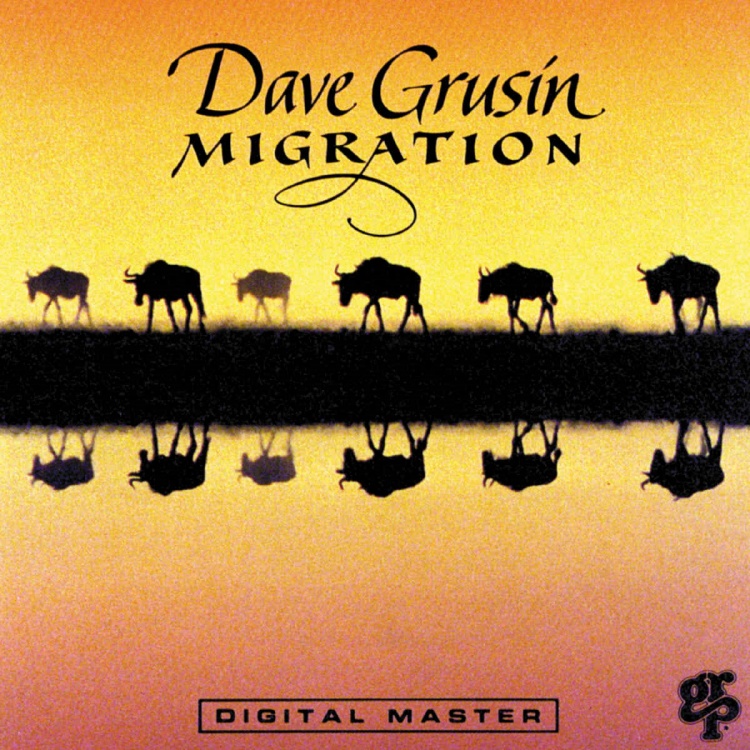
Dave Grusin “Migration”
Dave Grusin’s Migration album has been a favorite of mine since its release. The sound and music are so good that I used to demo the CD back in the early 1990’s. For this review, I listened to the score for the music to the Milagro Beanfield War which is included toward the end of the CD. Using the Rega Kytes as the main, I noticed how well the Klipsch RP-1600SW blended acoustically with the Kites. The Kites are small bookshelf speakers, and they have good low-end output down to about 60Hz. With the Klipsch RP-1600RW, the Kytes sounded much bigger. This happened mostly when the orchestra comes in with energy. The drums and the bass are reproduced with impressive heft and weight. The music score has some very syncopated rhythms and pulses for the instruments. I was impressed with how the Klipsch RP-1600SW was able to nimbly keep pace during these sequences. The Rega Kytes are very detailed and natural-sounding speakers so matching a subwoofer with them can be a challenge. Once I set the crossover at 80Hz and adjusted the gain, I felt that the Klipsch RP-1600SW blended seamlessly with the Rega Kytes.

Justice League
I enjoy DC and Marvel comic hero movies. Justice League is one of my favorites and to see how the RP-1600SW handled this film I mostly focused on the underground tunnel battle scene with Steppenwolf, and the final battle. My favorite comic character has always been Batman and I liked the Bat Crawler in the Tunnel sequence. With the Rega Kytes, the RP-1600SW added ominous undertones to the sound effects and the music. The Klipsch woofer blended so seamlessly that it seemed as if the bookshelf Rega Kytes was providing much of this added heft. During the crashes and explosions, the RP-1600SW added the impact and punch of the soundtrack clearly and distinctly. The Klipsch RP-1600SW’s control over the low frequencies allowed for added clarity to the soundtrack. When there were crashes or explosions the Klipsch RP-1600SW shook the room. The lack of distortion with the Klipsch RP-1600SW is remarkable. Too often I have listened to home theater systems that have what I would call a running bass drone. The bass is droning continuously on these systems, and I find it fatiguing and annoying. Not so with the Klipsch RP-1600SW. The low bass is in and out quick, and the RP-1600SW delivers a very clean sound. Switching to the NHT C-4’s I had more midbass energy and a slightly bigger sound, but all the positives I heard with the Kytes in the system were evident through the Klipsch RP-1600SW.
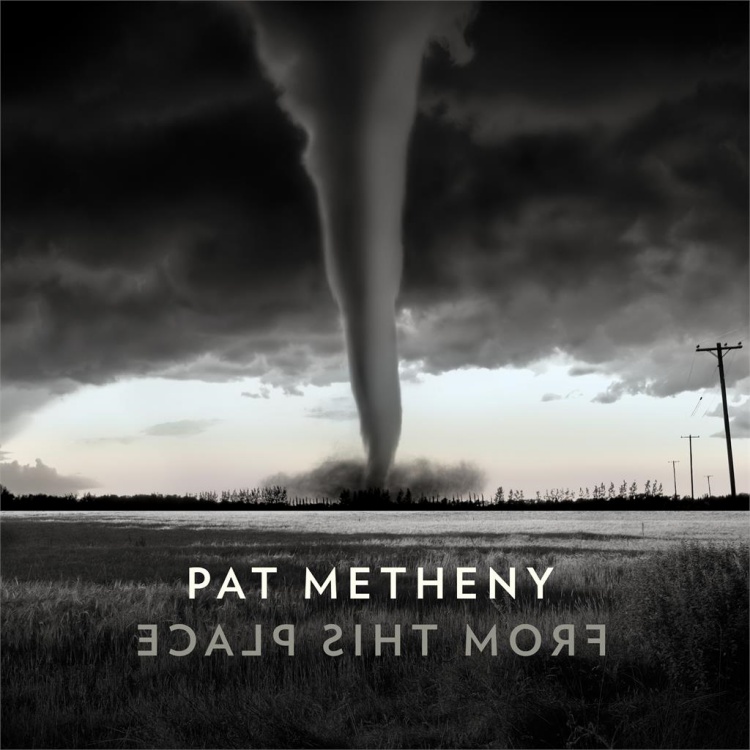
Pat Metheny “From This Place”
Pat Metheny’s From This Place is a sprawling, complex work with much instrumentation and sound effects (for example, a train at a railroad crossing). The recording quality on this album is fabulous. I was especially looking forward to hearing bass player Linda May Han Oh. She adds incredible intricate bass lines. Listening with the NHT C-4s and the Klipsch RP-1600SW I heard a huge sound stage, which is befitting of this music. The bass, along with the drums, piano, guitar, strings, etc. was presented in an intoxicating way. The RP-1600SW brought life and energy to the system. What I also noticed over time was that with either the NHT C-4s or the Rega Kytes, the sound with the Klipsch RP- 1600SW was intensely musical. The added depth and foundation that the Klipsch RP-1600SW brought to the sound made the listening sessions extremely enjoyable.
The Klipsch RP-1600SW is a capable, high-performance subwoofer that is a bargain at its price.
- Superior Sound Reproduction
- Ease of calibration and use
- Attractive cabinet
- Fully Adjustable Phase Control
- Balanced inputs???
Having owned and listened to subwoofers in sound systems for over four decades, I can say that I have had my share of ear-opening experiences and endless frustrations with subs. Frustrating because although a sub can bring a positive amount of low end to a system, it too often can also detract by not blending well with the main speakers. Not so with the Klipsch RP-1600SW. The low distortion and power of this sub made for some compelling listening sessions.
Now, no matter how “full range” a speaker is, the addition of a good subwoofer does add benefits to a system. Sometimes, the added subwoofer will add some benefits at the expense of other aspects of a speaker/system performance. I am happy to tell you that the Klipsch RP-1600SW is easy to set up and use. More importantly, I believe that this subwoofer will easily blend with almost any room, speaker, or equipment it can be used with.
Klipsch has engineered and admirably manufactured the RP-1600SW. Very professional, and masterful in performance and features, the RP-1600SW provided a very musical presentation with the various speakers and equipment I used it with. For those of you who own Klipsch speakers, I can only say that the RP-1600SW will be a match made in heaven. Listening at length to the RP-1600SW, I felt it proved to be addictive during listening sessions. The Klipsch RP-1600SW is very highly recommended for serious music lovers.




